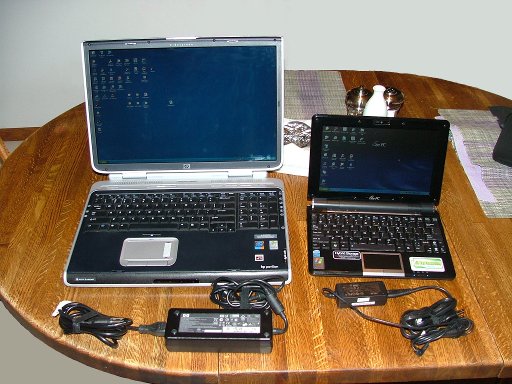
Let's put that previous picture into proper perspective. In the photo below, my heavy-duty
(and I do mean heavy-duty Hewlett-Packard ZD8000 is on the left, and my new
Asus Eee PC-1000HE is on the right: (click on the picture for a higher-resolution view):

The two computers are shown with their corresponding AC adapters on my dining room table. Sorry about the clutter in the photo. I cleaned it up a little bit with a photo editor, but I know that I should eventually take a more properly-staged photo. I've spent too much time away from one of my other hobbies, photography. :(
Note the huge difference in size. Imagine the difference in weight. Sure, the screen sizes are markedly different, to the disadvantage of the netbook, but it's still a far better screen than my Samsung Instinct phone or my Palm T|X PDA. Surprisingly, the keyboard of the netbook computer is very well-designed, with keys that are more than 90% of the size of a full-size keyboard, not some tiny little pushbuttons like some netbook computers. Given the far lower power needs of the netbook, the AC adapter is much smaller. And its output is 12V DC, a voltage that is very easy to obtain from an automobile, for mobile use, unlike the ZD8000 which needs 19 volts at a whole-lotta-amps! To run the ZD8000 in a vehicle for more than the 1-2 hour capacity of its internal batteries, you will have to step up your vehicle's 13.8 VDC to 120 VAC with an inverter, and then connect that to the AC adapter shown here. Ugh!
Let's take a quick tour of the outside of this little gem.
Here is the Eee PC with the lid closed.
_Closed_lid.jpg)
Here is the Eee PC with the lid opened up.
_Opened_Up.jpg)
Here is the Eee PC 1000 HE compared in size to a standard CD jewel case.
_Size_Comparison_to_CD_case.jpg)
Keep in mind that this photo is intended to show the size of the netbook next to something
that most of us can relate to. But be aware that this netook, like most of them, does not
have a built-in CD or DVD drive. I did buy an aftermarket external DVD recorder/player drive
that plugs into two USB ports of the netbook (no other power or connectors needed), for those
rare times that I need to read or write a CD or DVD with the netbook computer.
Here is a comparison of the Eee PC 1000 HE to the Apple iBook computer:
_Size_Comparison_to_Apple_iBook.jpg)
Here is a view of the opened-up netbook computer looking straight at the screen.
_Face_On.jpg)
To the right of the touchpad, at the front edge of the chassis, are the cool blue
LED indicators.
_LEDs.jpg)
The power indicator LED is actually tri-color, showing different colors for
different states, such as running on battery, plugged in, low battery, etc.
There is a disk activity LED, as well as a Wi-Fi activity LED.
Here is the left side of the netbook.
_Left_Side.jpg)
The openings and connectors on this side are...
Here is the right side of the netbook.
_Right_Side.jpg)
Visible on this side are...
Here is the bottom of the netbook.
_Bottom.jpg)
Here is the bottom, after the panel has been removed to allow access the
insides of the netbook. This is where you can add either of two system
upgrades, should you choose to do so.
_Bottom_with_Cover_Off.jpg)
Note that there is only a single memory module. A 1 Gb module is standard,
but I replaced that with a 2 Gb module, which is the largest size that Asus
supports.
Note the 160 Gb 2.5" SATA hard drive. I replaced mine with a 128 Gb Solid State Disk (SSD) drive. Now, I don't have to worry at all about using the netbook in a high vibration environment such as a car, boat, airplane, etc., and the netbook is more impervious to accidental drops or bumps. Of course, the LCD screen is still made of breakable glass, and can be shattered if you are a real klutz, but I do try to take care of my stuff! Anyway, I put the original 160 Gb hard drive into an external case that uses either USB or eSATA connectivity, and have some extra storage available for any of my computers. The way I looked at it, my older HP ZD8000 has served me very well for many years with its 100 Gb hard drive, so even though I gave up 28 Gb of storage by switching from the spinning hard drive to the silent, low power, high speed, low heat, reliable SSD drive, I still had more storage capacity in the netbook than I have in the larger laptop. And I also have the 160 Gb drive available as external storage if I want to plug it into the USB port of either portable computer, or to the eSata port of my desktop computer! Can you say "win-win scenario"?
Ok, that's the quick tour of the outside. One of my biggest hang-ups with portable computers of all sorts has always been the keyboards, which never seem to be good enough for my tastes. They tend to be too small and cramped, or too mushy, or too short of a travel distance, or laid out in an awkward and non-standard arrangement, or all of the above.
Let's take a look at the keyboard of the Eee PC 1000 HE... (Click here for Page 3)
Last edited September 5, 2010 by WØJT